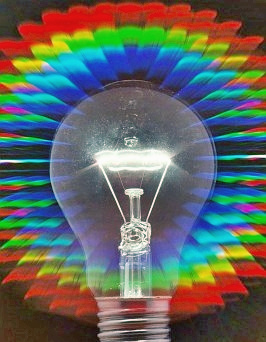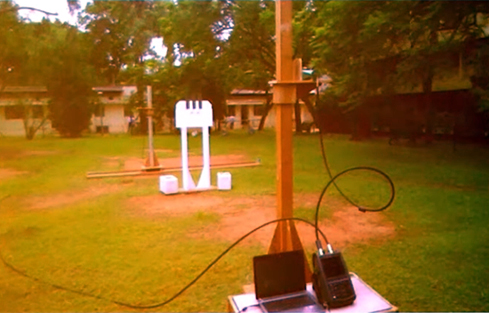Someone went and got me a subscription to Scientific American, which is nice. Haven’t read one of those since before my PhD. In theory, I should be able to understand it a lot better. In practice, popular articles often omit crucial details or use “creative” explanations that would confuse most professionals.
So I went straight to the physics section and found an article titled “The Triple Slit Experiment” by Urbasi Sinha. Already this has me a bit confused. What’s so special about three slits? And why stop at 3? You can just have slits repeating indefinitely. It’s called a diffraction grating, and I had one when I was a kid (from this book).

Diffraction gratings turn everything to rainbows, and are great toys. Credit: Wikimedia Commons
So I looked through the article to see what was going on. The article makes three main points:
- The usual way to understand the double-slit experiment is by summing the probability amplitudes from each slit. But theoretically, there is a small correction term, which is proportional to the “Sorkin parameter”.
- The author measured a nonzero Sorkin parameter with a precise triple-slit experiment.
- These results work towards the possibility of quantum computers using qutrits. A qutrit is like a qubit but has 3 states instead of two. So when making quantum computers, each qutrit is worth a little more than a single qubit.
This is neat, and I particularly liked the part where they performed an experiment in the middle of a corn field, because apparently corn absorbs microwaves. I went looking for a photo, and I believe this is it:

From a presentation by Sinha, timestamp 39:26. I applied some color correction to save your eyes. Hmm… less corn than I imagined. The slits are quite big because they’re working with microwaves, which have fairly long wavelengths.
But the article raises a lot of questions. There’s a lot of connective tissue missing, likely because the average reader is struggling to understand just the basics. I don’t know what the Sorkin parameter is or where it comes from. If they measured the Sorkin parameter, how large is it? I also don’t understand the rationale for the triple-slit experiment, given that the Sorkin parameter applies equally well to a double-slit experiment.
I’m also very skeptical that triple-slit qutrits are fertile ground for quantum computing. But I’d forgive the author for that one, because it’s just some pie-in-the-sky speculation, as appears in many scientific papers. None of us know which pies in which skies will prove fruitful.
Anyway, to fill in some gaps left by the article, I watched some of Sinha’s presentation, and I think I get it.
The Sorkin parameter arises from paths that traverse the slits more than once. For instance, one path could go through slit A, then back through slit B, and back again through slit C. Obviously this path would be blocked off if any of the three slits were closed, so it’s not enough to sum up each slit independently. This isn’t a uniquely quantum effect, as far as I can tell. You could theoretically measure the same effect with any kind of wave, like sound waves. (Although I’ve never heard of a double-slit experiment with sound waves, so there are probably some practical challenges.)
The exact Sorkin parameter is not given because it depends on the wavelength of light, distance between slits, and so on. In the talk, Sinha described one experiment where the Sorkin parameter would be 0.001, which is to say that it affects the naive predictions by one part in a thousand. The Sorkin parameter applies to any number of slits, but something about the math apparently makes a triple-slit experiment more sensitive, that’s all.
If you enjoy me struggling through popular physics articles, let me know and I can do it more often.

“You could theoretically measure the same effect with any kind of wave, like sound waves. (Although I’ve never heard of a double-slit experiment with sound waves, so there are probably some practical challenges.)”
Back when I did an attempt at teaching high school, we did some double-slit experiments using water waves. Nice bit is you can actually see the interference patterns.
This paper by Sinha et al claims that their experiment provides a bound on the accuracy of Born’s rule. It’s doing no such thing. It’s measuring deviation from a naive application of Born’s rule which treats the slits as independent sources.
They also seem a bit confused (or maybe it’s me that’s confused).
If the Sorkin parameter arises from exotic paths (like through A, back through B, out through C), those are still single paths which contribute to the amplitude.
@Rob Grigjanis #2,
My guess is that this paper, which is from 2010, showcases an earlier (mis)interpretation of their experiments, where they thought that any deviation from prediction would mean there was a deviation from Born’s rule. A 10^-2 bound sounds pretty unimpressive to me, but maybe they were thinking of it as a proof of concept for a more precise measurement. Then, when they got more precise measurements, they found a deviation. That would have been very exciting, but after talking to some people they realized that the Sorkin parameter was a much better explanation. Now they’re framing it as if that’s what they intended to measure all along–classic scientist storytelling.